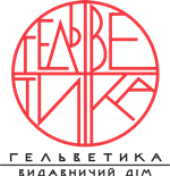COLOR IN THE DESIGN OF EDUCATIONAL MATERIALS FOR CHILDREN 3–6 YEARS OLD
DOI:
https://doi.org/10.32782/uad.2023.4.2Keywords:
design, color, decoration, educational materials, publications for children.Abstract
The aim of the article is to study the meaning of color and the features of its application for visualization of educational information in the design layouts of educational publications for children 3-6 years old. Manuals for children, created by modern Ukrainian and foreign designers, are considered, their comparative analysis is carried out, various methods of using color in external and internal design, illustrations, décor, schemes, symbols, font highlights, headings etc. are revealed. An original approach to the design of specific samples of manuals depending on the subject, author’s style, pedagogical methods, methodological content and educational goals is noted; the characteristics of color solutions and techniques are systematized. An assessment of the designers’ choice of colors was carried out, paying attention to such aspects as brightness, contrast, tone and symbolic connotations inherent in each author, as well as taking into account the peculiarities of perception and recognition of colors by children of different ages, as evidenced by the works of child psychologists and practicing teachers analyzed by us, as well as compliance with qualilogical, health-preserving requirements for printed products. Thus, the emphasis is placed not only on the aesthetic aspect of using color to create an attractive visual image of the manual, which is important for the development of aesthetic feelings and creative abilities, but also on the purely functional, practical value of color solutions to facilitate children to perform specific tasks, memorize, assimilate educational material, and develop intellectual skills. Through observations, careful analysis, the aspects of improvement, modernization of educational publications for preschoolers and young students through the competent use of color to create vivid visual images, structuring the text and extra-textual elements, maximum visualization of educational material is carried out.The results of the study of the use of color are important for the development of new design projects, the search for techniques for modernizing and aestheticizing textbooks, strengthening their functionality and effectiveness.
References
Федієнко В. А. Математика. Подарунок маленькому генію. Харків : Видавничий дім «ШКОЛА», 2021. 48 с.
Волкова Ю. С., Федієнко В. А. Розвиток мислення. Високий рівень. Методика інтенсивного розвитку дітей 4–6 років / за ред. Р. Дерев’янченко; худ. Начинова І., Гец М., Житник Є. Харків : Видавничий дім «ШКОЛА», 2009. 64 с.
Федієнко В. Ми готуємось до школи без проблем : робочий зошит для дітей 4–6 років / за ред. Дерев’янченко Р. ; худ. Начинова І., Гец М., Житник Є. Харків : Видавничий дім «ШКОЛА», 2018. 128 с.
Гавріна С. Є. Розумне дошкільнятко. Велика книга тестів. 3–4 роки / за ред. Добоні М. ; худ. Богачов. С. Київ : Перо, 2015. 112 с.
Ігнатьєва С. А., Назаренко А. А. Велика книга дошкільнятка. Харків : «Торсинг плюс», 2016.
с.
Czarnecka, J. (2019). Sprytne smyki 3. Warszawa: AWM. 80 с.
Małachowska, M. (2019). Mój elementarz. Nauka czytania, nauka pisania. Kraków: Wydawnictwo Greg. 140 с.
Sank Magic Practice Copybook. Mumbai: Sank publishing. 2022. 64 с.
The Preschool Activity Book: Scholastic Early Learners (Activity Book). New York: Cartwheel Books. 2023. 74 с.
Шалварова К. С., Сова О. С. Сучасне навчальне видання: естетика і функціональність. Мистецтво та освіта. 2021. № 3(101) С. 46–51. DOI: https://doi.org/10.32405/2308-8885-2021-3(101)-46-51
Погонець І.В. Роль ілюстративного матеріалу у структурі підручників, адресованих молодшим школярам (друга половина ХХ століття). Проблеми сучасного підручника. 2017. Вип. 18. С. 154–161.
Гнідець У. С. Художня специфіка літератури для дітей та юнацтва: Комунікативний аспект. Матеріали науково-практичної конференції «Дитина читає…». Київ–Львів. Національний педагогічний університет ім. М. П. Драгоманова, 2008. С. 36–43.
Гнідець У. С. Візуалізація образу дитини як спосіб здійснення літературної комунікації. Український науковий збірник. Вип. 119(2). Львів : Львівський національний університет імені Івана Франка, 2007. С. 68–75.
СОУ 18.1-02477019-11:2014. Видання для дітей. Загальні технічні вимоги. Національні стандарти України. URL: http://www.ukrbook.net/vidavc.html (дата звернення 7.11.2023).
СОУ 18.1-02477019-07:2015. Поліграфія. Підручники і навчальні посібники для загальноосвітніх навчальних закладів. Національні стандарти України. URL: http://www.ukrbook.net/vidavc.html (дата звернення 7.11.2023).
Дубневич М. М. Кваліметричний аналіз поліграфічного оформлення книжкових видань для дітей. Поліграфія і видавнича справа. 2016/2(72). С. 154–161.
Bornstein, M. H. (1973). Color vision and color naming: A psychophysiological hypothesis of cultural difference. Psychological Bulletin, 80(4), 257–285. DOI: https://doi.org/10.1037/h0034837
Macleod, Donald I.A., (2003) Colour Discrimination, Colour Constancy and Natural Scene Statistics , in John D. Mollon, Joel Pokorny, and Ken Knoblauch (eds), Normal and Defective Colour Vision. С. 189–217. DOI: https://doi.org/10.1093/acprof:oso/9780198525301.003.0021
Gegenfurtner, K. R., Kiper, D. C. (2003). Color vision. Annual Review of Neuroscience, 26, 181–206. DOI: https://doi.org/10.1146/annurev.neuro.26.041002.131116
Сastella, К. (2018). Designing for Kids: Creating for Playing, Learning, and Growing. New York: Routledge. 476с.







